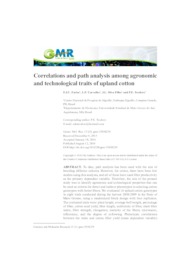Correlations and path analysis among agronomic and technological traits of upland cotton.
Correlations and path analysis among agronomic and technological traits of upland cotton.
Author(s): FARIAS, F. J. C.; CARVALHO, L. P. de; SILVA FILHO, J. L. da; TEODORO, P. E.
Summary: To date, path analysis has been used with the aim of breeding different cultures. However, for cotton, there have been few studies using this analysis, and all of these have used fiber productivity as the primary dependent variable. Therefore, the aim of the present study was to identify agronomic and technological properties that can be used as criteria for direct and indirect phenotypes in selecting cotton genotypes with better fibers. We evaluated 16 upland cotton genotypes in eight trials conducted during the harvest 2008/2009 in the State of Mato Grosso, using a randomized block design with four replicates. The evaluated traits were: plant height, average boll weight, percentage of fiber, cotton seed yield, fiber length, uniformity of fiber, short fiber index, fiber strength, elongation, maturity of the fibers, micronaire, reflectance, and the degree of yellowing. Phenotypic correlations between the traits and cotton fiber yield (main dependent variable were unfolded in direct and indirect effects through path analysis. Fiber strength, uniformity of fiber, and reflectance were found to influence fiber length, and therefore, these traits are recommended for both direct and indirect selection of cotton genotypes.
Publication year: 2016
Types of publication: Journal article
Unit: Embrapa Cotton
Keywords: Algodão, Cotton, Fibra, Gossypium hirsutum, Melhoramento genético, Upland cotton
Observation
Some of Embrapa's publications are published as ePub files. To read them, use or download one of the following free software options to your computer or mobile device. Android: Google Play Books; IOS: iBooks; Windows and Linux: Calibre.
Access other publications
Access the Agricultural Research Database (BDPA) to consult Embrapa's full library collection and records.
Visit Embrapa Bookstore to purchase books and other publications sold by Embrapa.

